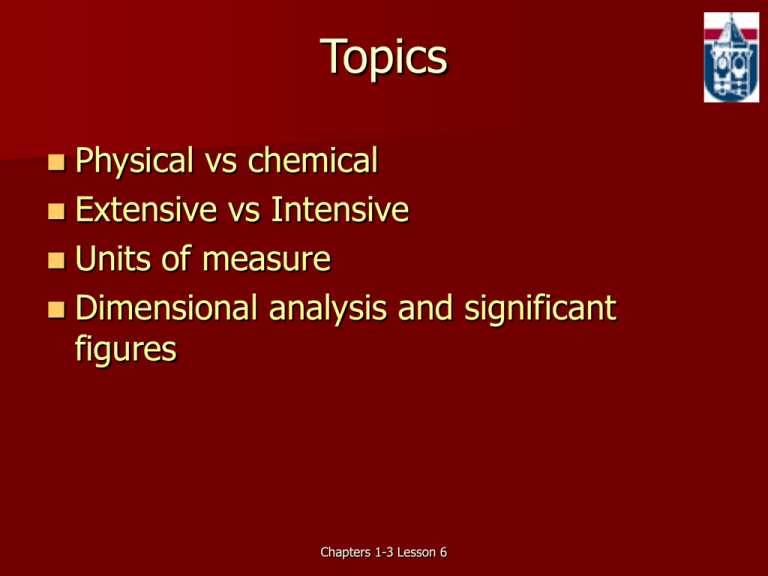Ch1-3lsn6_105 - Chemistry at Winthrop University
advertisement

Topics Physical vs chemical Extensive vs Intensive Units of measure Dimensional analysis and significant figures Chapters 1-3 Lesson 6 Problems 2.115 & 2.116 Classify each of the following as a compound, a homogeneous mixture, or a heterogeneous mixture Distilled water orange juice Gasoline vegetable soup Beach sand cement Wine calcium sulfate Air tea Chapters 1-3 Lesson 6 Problems 2.115 & 2.116 homogeneous mixture Gasoline Wine Air Tea heterogeneous mixture Beach sand orange juice cement vegetable soup compound Distilled water calcium sulfate Chapters 1-3 Lesson 6 1-80 Carry out the following calculation, and report the answer with the correct number of significant figures. (1.68) 23.56 – 2.3 1.248 X 103 Chapters 1-3 Lesson 6 Chemical Problem Solving: A Systematic Approach to Solving Chemistry Problems What is the price of 325 cm of wire if the wire costs $0.15/ft? 2.54 cm = 1.0 in 12.0 in = 1.0 ft Chapters 1-3 Lesson 6 Chemical Problem Solving: A Systematic Approach to Solving Chemistry Problems Price of 325 cm of wire @ $0.15/ft? 2.54 cm = 1.0 in & 12.0 in = 1.0 ft 325 cm 1.0 in 1.0 ft $0.15 -------- ------ ------ = $1.60 2.54 cm 12.0 in 1.0 ft Chapters 1-3 Lesson 6 Measurement in Scientific Study: Some Important SI Units in Chemistry PROBLEM 1.3 If you submerge a steel cube 15.0 mm on each side in 31.8 mL of water in a graduated cylinder, what is the total volume (in L) of the cylinder contents? 31.8 mL Chapters 1-3 Lesson 6 Measurement in Scientific Study: Some Important SI Units in Chemistry PROBLEM 1.4 If a raindrop weighs 65 mg on average and 5.1 x 105 raindrops fall on a lawn every minute, what mass (in kg) of rain falls in 1.5 h? Chapters 1-3 Lesson 6 Measurement in Scientific Study: Some Important SI Units in Chemistry PROBLEM 1.5 The piece of galena in Sample Problem 1.3 has a volume of 4.6 cm3. If the density of galena is 7.5 g/cm3, what is the mass (in kg) of that piece of galena? Chapters 1-3 Lesson 6 Uncertainty in Measurement: Significant Figures: Determining Which Digits Are Significant PROBLEM 1.7 For each of the following quantities, underline the zeros that are significant figures and determine the number of significant figures (sf) in each quantity. For (d) to (f), express each in exponential notation first. – (a) 31.070 mg – (b) 0.06060 g – (c) 850. oC (d) 200.0 mL (e) 0.0000039 m (f) 0.000401 L Chapters 1-3 Lesson 6 Problem 2.18 Fluorite, a mineral of calcium, is a compound of the metal with fluorine. Analysis shows that a 2.76-g sample of fluorite contains 1.42-g of calcium. Calculate the (a) mass of fluorine in the sample; (b) mass fractions of calcium and fluorine in fluorite; (c) mass percents of calcium and fluorine in fluorite. Chapters 1-3 Lesson 6 MTS 2 Write the notation for each atomic depiction. 47 e- 28 e47 p+ 62 n0 28 p+ 33 n0 Chapters 1-3 Lesson 6 MTS 3 Calculating an atomic mass from isotopic composition (SP2.3) Magnesium has three naturally occurring isotopes, 24Mg (isotopic mass 23.9850 amu, abundance 78.99%), 25 Mg (isotopic mass 24.9858 amu, abundance 10.00%), and 26Mg (isotopic mass 25.9826 amu, abundance 11.01%). Calculate the atomic mass of magnesium. (EOT 2.46) Chapters 1-3 Lesson 6 MTS 3 Calculating an atomic mass from isotopic composition (SP2.3) Copper has two naturally occurring isotopes, 63Cu (isotopic mass 62.9396 amu) and 65Cu (isotopic mass 64.9278 amu). If copper as an atomic mass of 63.546 amu, what is the percent abundance of each isotope? (EOT 2.48) Chapters 1-3 Lesson 6 Problem 4 A flask has a mass of 78.23 g when empty and 593.63 g when filled with water. When the same flask is filled with concentrated sulfuric acid, H2SO4, its mass is 1026.57 g. What is the density of concentrated sulfuric acid? The density of water at 25 oC is 0.99707 g/cm3. Mass H2O = 593.63 g – 78.23 g = 515.40 g Volume H2O = m/D = 516.9146 cm3 Mass H2SO4 = 1026.57 g – 78.23 g = 948.34 g D H2SO4 = m/V = 1.834616 g/cm3 = 1.8346 g/cm3 Chapters 1-3 Lesson 6 Problem 6 Hoffmannium has three common isotopes: 336Hm, 338Hm, and 340Hm. If the abundance of 340Hm is 5.023 %, what are the abundances of 336Hm and 338Hm? The mass of 336Hm is 335.99452 amu, 338Hm is 337.98638 amu, and 340Hm is 339.97481 amu. The mass of naturally occurring hoffmannium is 336.8751 amu. 60.8% = 336Hm 34.2% = Chapters 1-3 Lesson 6 338Hm Problem 3 The average density of the Earth is 5.52 g/cm3. What is the density in lb/ft3? 345 lb/ft3 Chapters 1-3 Lesson 6 Chemical Problem Solving: A Systematic Approach to Solving Chemistry Problems A furniture factory needs 31.5 ft2 of fabric to upholster one chair. Its Dutch supplier sends the fabric in bolts of exactly 200 m2. What is the maximum number of chairs that can be upholstered by 3 bolts of fabric (1 m = 3.281 ft)? Chapters 1-3 Lesson 6 Measurement in Scientific Study: Some Important SI Units in Chemistry PROBLEM 1.6 Mercury melts at 234 K, lower than any other pure metal. What is its melting point in oC and oF? T (K) = T (oC) + 273.15 T (oC) = T (K) – 273.15 T (oF) = 9/5 T (oC) + 32 = 1.8 T (oC) + 32 Chapters 1-3 Lesson 6







